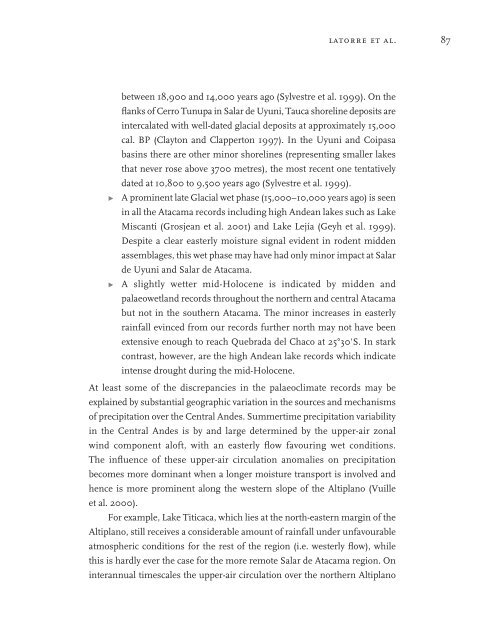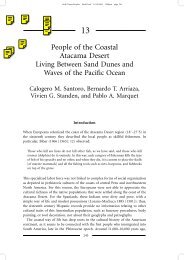Late Quaternary History of the Atacama Desert.
Late Quaternary History of the Atacama Desert.
Late Quaternary History of the Atacama Desert.
Create successful ePaper yourself
Turn your PDF publications into a flip-book with our unique Google optimized e-Paper software.
latorre et al. 87between 18,900 and 14,000 years ago (Sylvestre et al. 1999). On <strong>the</strong>flanks <strong>of</strong> Cerro Tunupa in Salar de Uyuni, Tauca shoreline deposits areintercalated with well-dated glacial deposits at approximately 15,000cal. BP (Clayton and Clapperton 1997). In <strong>the</strong> Uyuni and Coipasabasins <strong>the</strong>re are o<strong>the</strong>r minor shorelines (representing smaller lakesthat never rose above 3700 metres), <strong>the</strong> most recent one tentativelydated at 10,800 to 9,500 years ago (Sylvestre et al. 1999).Ω A prominent late Glacial wet phase (15,000–10,000 years ago) is seenin all <strong>the</strong> <strong>Atacama</strong> records including high Andean lakes such as LakeMiscanti (Grosjean et al. 2001) and Lake Lejía (Geyh et al. 1999).Despite a clear easterly moisture signal evident in rodent middenassemblages, this wet phase may have had only minor impact at Salarde Uyuni and Salar de <strong>Atacama</strong>.Ω A slightly wetter mid-Holocene is indicated by midden andpalaeowetland records throughout <strong>the</strong> nor<strong>the</strong>rn and central <strong>Atacama</strong>but not in <strong>the</strong> sou<strong>the</strong>rn <strong>Atacama</strong>. The minor increases in easterlyrainfall evinced from our records fur<strong>the</strong>r north may not have beenextensive enough to reach Quebrada del Chaco at 25°30'S. In starkcontrast, however, are <strong>the</strong> high Andean lake records which indicateintense drought during <strong>the</strong> mid-Holocene.At least some <strong>of</strong> <strong>the</strong> discrepancies in <strong>the</strong> palaeoclimate records may beexplained by substantial geographic variation in <strong>the</strong> sources and mechanisms<strong>of</strong> precipitation over <strong>the</strong> Central Andes. Summertime precipitation variabilityin <strong>the</strong> Central Andes is by and large determined by <strong>the</strong> upper-air zonalwind component al<strong>of</strong>t, with an easterly flow favouring wet conditions.The influence <strong>of</strong> <strong>the</strong>se upper-air circulation anomalies on precipitationbecomes more dominant when a longer moisture transport is involved andhence is more prominent along <strong>the</strong> western slope <strong>of</strong> <strong>the</strong> Altiplano (Vuilleet al. 2000).For example, Lake Titicaca, which lies at <strong>the</strong> north-eastern margin <strong>of</strong> <strong>the</strong>Altiplano, still receives a considerable amount <strong>of</strong> rainfall under unfavourableatmospheric conditions for <strong>the</strong> rest <strong>of</strong> <strong>the</strong> region (i.e. westerly flow), whilethis is hardly ever <strong>the</strong> case for <strong>the</strong> more remote Salar de <strong>Atacama</strong> region. Oninterannual timescales <strong>the</strong> upper-air circulation over <strong>the</strong> nor<strong>the</strong>rn Altiplano
















